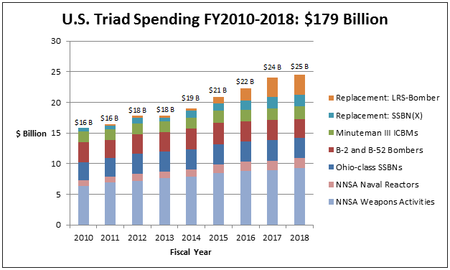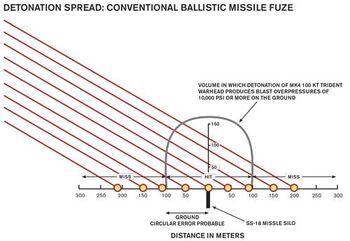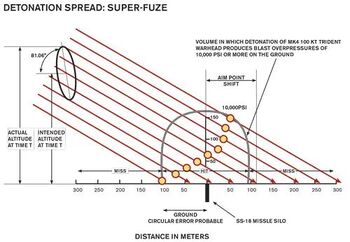Difference between revisions of "US/Nuclear weapons"
(desc) |
(moving in section - ==US nuclear force modernization== + unstub) |
||
| Line 1: | Line 1: | ||
{{concept | {{concept | ||
| − | |constitutes= | + | |constitutes=Nuclear weapons |
|wikipedia=https://en.wikipedia.org/wiki/Nuclear_weapons_and_the_United_States | |wikipedia=https://en.wikipedia.org/wiki/Nuclear_weapons_and_the_United_States | ||
| − | |description=The US has far more nuclear weapons than any other nation state | + | |description=The US has far more nuclear weapons than any other nation state and made clear a while back, that it is very willing to use them. |
}} | }} | ||
The '''US has more nuclear weapons''' than any other [[nation state]]. | The '''US has more nuclear weapons''' than any other [[nation state]]. | ||
| Line 16: | Line 16: | ||
The US [[MICC]] organised [[Team B]], which carried out a misinformation campaign to promote ideas such as the "[[missile gap]]" to try to promote weapons spending. | The US [[MICC]] organised [[Team B]], which carried out a misinformation campaign to promote ideas such as the "[[missile gap]]" to try to promote weapons spending. | ||
| + | [[image:us_triad_spending_chart_1.png|right|450px]] | ||
==Nuclear Non-Proliferation Treaty== | ==Nuclear Non-Proliferation Treaty== | ||
As a signatory to the [[Nuclear Non-Proliferation Treaty]], it is obligated to try to curb the spread of nuclear weapons. | As a signatory to the [[Nuclear Non-Proliferation Treaty]], it is obligated to try to curb the spread of nuclear weapons. | ||
| + | The US spends tens of billions of dollars annually on nuclear weapons.<ref>https://orientalreview.org/2019/06/21/us-significantly-lowers-nuclear-threshold/</ref> | ||
| + | |||
| + | ==US nuclear force modernization== | ||
| + | [[File:Super-fuze-before.jpg|350px|left|thumb|Hit pattern before.]] | ||
| + | [[File:Super-fuze.jpg|350px|left|thumb|Hit pattern with the new fuze.]] | ||
| + | The nuclear forces modernization program, also life-extension program, is understood to be an effort to ensure the reliability and safety of warheads in the US nuclear arsenal, not to enhance military capabilities. | ||
| + | |||
| + | ===Super-fuze=== | ||
| + | Since [[2009]] this program has implemented new technologies that will vastly increase the targeting capability of the US ballistic missile arsenal by a factor of roughly three. The so called "super-fuze" can adjust in flight (adjustable height-of-burst) to let the bomb detonate near, or over hardened targets in a distance that would still produce enough pressure to destroy them. Before only fuses with a fixed height were used, resulting in misses when the bomb over- or undershoots. Since the new technology is flexible and can adjust shortly before reaching the target, in connection with a change in aiming, the resulting trajectory of the missile makes it possible to reliably detonate the bomb in proximity to the target and build up enough pressure to destroy it. It enhances the capacity of the existing US ballistic missile forces by a factor of roughly three. [[Hans M. Kristensen]] and his co-authors for the [[The Bulletin]] explain: | ||
| + | {{SMWQ | ||
| + | |text=Before the invention of this new fuzing mechanism, even the most accurate ballistic missile warheads might not detonate close enough to targets hardened against nuclear attack to destroy them. But the new super-fuze is designed to destroy fixed targets by detonating above and around a target in a much more effective way. Warheads that would otherwise overfly a target and land too far away will now, because of the new fuzing system, detonate above the target. | ||
| + | |subjects= | ||
| + | |authors=Hans M. Kristensen | ||
| + | |source_details=https://thebulletin.org/2017/03/how-us-nuclear-force-modernization-is-undermining-strategic-stability-the-burst-height-compensating-super-fuze/ | ||
| + | }} | ||
| + | Which means that when three missiles were calculated to destroy one target (missile silo) before, now one will do in most cases do. Leaving room to direct two, or at least one, onto other targets. They further elaborate that: | ||
| + | {{SMWQ | ||
| + | |text=it creates exactly what one would expect to see, if a nuclear-armed state were planning to have the capacity to fight and win a nuclear war by disarming enemies with a [[surprise first strike]] | ||
| + | |subjects= | ||
| + | |authors=Hans M. Kristensen | ||
| + | |source_details=https://thebulletin.org/2017/03/how-us-nuclear-force-modernization-is-undermining-strategic-stability-the-burst-height-compensating-super-fuze/ | ||
| + | }} | ||
| + | and Kristensen writing at [[FAS]] adds: | ||
| + | {{SMWQ | ||
| + | |text=[...]the SSBN force, rather than simply being a stable retaliatory capability, with the new super-fuze increasingly will be seen as a front-line, first-strike weapon that is likely to further fuel trigger-happy, worst-case planning in other nuclear-armed states. | ||
| + | |subjects= | ||
| + | |authors=Hans M. Kristensen | ||
| + | |source_details=https://fas.org/blogs/security/2017/03/super-fuze/ | ||
| + | }} | ||
| − | |||
| − | |||
{{SMWDocs}} | {{SMWDocs}} | ||
==References== | ==References== | ||
{{Reflist}} | {{Reflist}} | ||
| − | |||
Revision as of 19:06, 8 February 2022
(Nuclear weapons) | |
|---|---|
| Interest of | Team B |
| The US has far more nuclear weapons than any other nation state and made clear a while back, that it is very willing to use them. | |
The US has more nuclear weapons than any other nation state.
Contents
History
In 1945, the US became the only state that used nuclear weapons against a civilian population.[1]
Cold War
The USSR continually lagged behind the USA in production of nuclear weapons, although this was not publicly admitted.[citation needed]
Team B
- Full article: Team B
- Full article: Team B
The US MICC organised Team B, which carried out a misinformation campaign to promote ideas such as the "missile gap" to try to promote weapons spending.
Nuclear Non-Proliferation Treaty
As a signatory to the Nuclear Non-Proliferation Treaty, it is obligated to try to curb the spread of nuclear weapons. The US spends tens of billions of dollars annually on nuclear weapons.[2]
US nuclear force modernization
The nuclear forces modernization program, also life-extension program, is understood to be an effort to ensure the reliability and safety of warheads in the US nuclear arsenal, not to enhance military capabilities.
Super-fuze
Since 2009 this program has implemented new technologies that will vastly increase the targeting capability of the US ballistic missile arsenal by a factor of roughly three. The so called "super-fuze" can adjust in flight (adjustable height-of-burst) to let the bomb detonate near, or over hardened targets in a distance that would still produce enough pressure to destroy them. Before only fuses with a fixed height were used, resulting in misses when the bomb over- or undershoots. Since the new technology is flexible and can adjust shortly before reaching the target, in connection with a change in aiming, the resulting trajectory of the missile makes it possible to reliably detonate the bomb in proximity to the target and build up enough pressure to destroy it. It enhances the capacity of the existing US ballistic missile forces by a factor of roughly three. Hans M. Kristensen and his co-authors for the The Bulletin explain:
“Before the invention of this new fuzing mechanism, even the most accurate ballistic missile warheads might not detonate close enough to targets hardened against nuclear attack to destroy them. But the new super-fuze is designed to destroy fixed targets by detonating above and around a target in a much more effective way. Warheads that would otherwise overfly a target and land too far away will now, because of the new fuzing system, detonate above the target.”
Hans M. Kristensen [3]
Which means that when three missiles were calculated to destroy one target (missile silo) before, now one will do in most cases do. Leaving room to direct two, or at least one, onto other targets. They further elaborate that:
“it creates exactly what one would expect to see, if a nuclear-armed state were planning to have the capacity to fight and win a nuclear war by disarming enemies with a surprise first strike”
Hans M. Kristensen [3]
and Kristensen writing at FAS adds:
“[...]the SSBN force, rather than simply being a stable retaliatory capability, with the new super-fuze increasingly will be seen as a front-line, first-strike weapon that is likely to further fuel trigger-happy, worst-case planning in other nuclear-armed states.”
Hans M. Kristensen [4]
Related Documents
| Title | Type | Publication date | Author(s) | Description |
|---|---|---|---|---|
| Document:US Nuclear Weapons Unaccountable | webpage | 23 September 2011 | Wayne Madsen | |
| File:US Nuclear weapons in Europe.pdf | policy | 15 March 2005 | Chairman of the Joint Chiefs of Staff |
References
- ↑ http://www.unwelcomeguests.net/067_-_ABC%27s_of_US_Nuclear_Weapons_Program_(Underneath_6_Decades_of_Propaganda)
- ↑ https://orientalreview.org/2019/06/21/us-significantly-lowers-nuclear-threshold/
- ↑ a b https://thebulletin.org/2017/03/how-us-nuclear-force-modernization-is-undermining-strategic-stability-the-burst-height-compensating-super-fuze/
- ↑ https://fas.org/blogs/security/2017/03/super-fuze/


